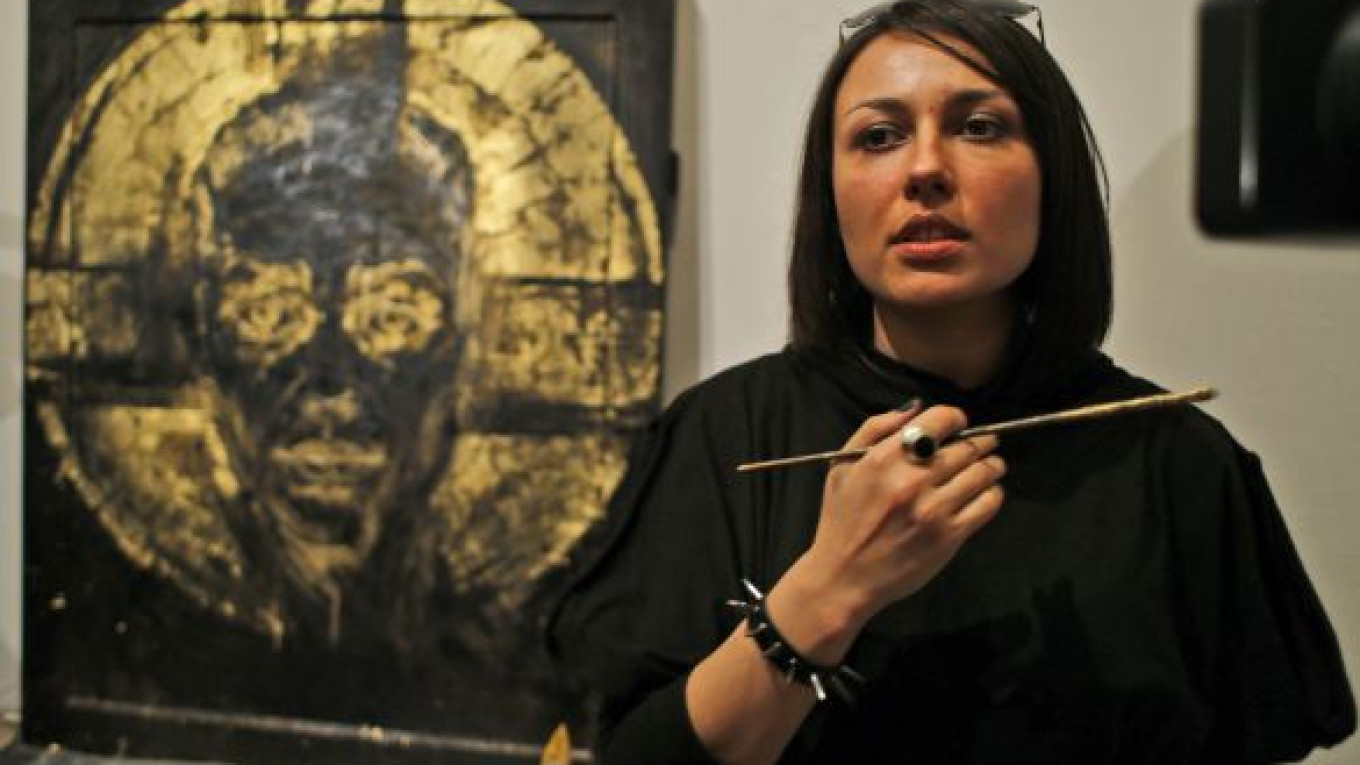Chaos ruled at the opening of an exhibition of "real icons" inspired by Pussy Riot, resulting in the arrest of nine protesters. On Thursday evening, about 20 Orthodox activists and Cossacks blocked the entrance to the Gelman Gallery at Winzavod Modern Art Center, where artist Yevgenia Maltseva's exhibition "Spiritual Combat" was due to be opened to the public.
The large-scale paintings, combining Orthodox imagery with Pussy Riot slogans, such as "Free," and the now-iconic balaclavas have incensed some members of the church.
The protesters, who initially tried to gain entrance to the gallery but were kept out by gallery personnel, could be heard outside chanting slogans such as "no to liberal fascism," while others sang songs against the Pussy Riot movement. One Cossack brandished a large whip.
Initially, two protesters were arrested after a heated fracas between bystanders, protesters and police. Twitter user erizo_rayado posted that "an old man in an 'Orthdoxy or death' T-shirt kicked me in the groin."
When the Cossacks said they had more than 200 supporters on their way, riot police were called. Officers arrived swiftly in four large police trucks.
Over the next two hours, the number of arrests rose to nine.
Among those arrested was anti-Pussy Riot activist Dmitry Enteo, who had posted on VKontakte in an attempt to raise awareness of the protest.
Gazeta.ru printed the message: "It will only take a few minutes to make your contribution," Enteo wrote. "Those who want to speak face to face with the organizer of this blasphemy, let me know. P.S. Can anyone give me a canister?"
A man who tore down exhibition posters and attempted to set fire to them was among those arrested.
Inside the exhibition, the artist was swamped by journalists eager to hear her response to the reaction outside. Maltseva remained cool and praised the museum staff for ensuring the security of the exhibition and the press.
Asked whether she feared a possible backlash against her work, she replied, "I haven't had time to think about it. There were no words for how I felt when Pussy Riot was sentenced. I had to do this. I haven't even had time to look at the paintings. I only finished at 2 o'clock last night."
All the works on display are titled either "painting" or "icon." The former are arresting and troubled impressionistic depictions of figures in balaclavas. Maltseva's furious brush strokes and use of vibrant color convey a violent emotional reaction to the fate of Pussy Riot.
Maltseva often wore a balaclava herself in the creation of these works, not to paint from life "but to feel a specific perspective on life."
The icons are clearly inspired by Byzantine painting and are suggestive of altarpieces depicting the Madonna and Child or a Pieta. Smeared gold paint and etched details convey the mournful gravitas of timeless religious artwork, and Maltseva's political subtext is restrained.
The imagery of Pussy Riot appears through large, shadowy eyes and indistinct features. These are beautifully executed works that have the potential to be admired even after the resonance of their political context has faded.
Interest from other galleries in her work has already begun, much of it from abroad.
"Here in Moscow, this is our story, but it is now on a worldwide scale," Maltseva said.
The exhibition has unsurprisingly divided visitors. Asked about their impressions of the artwork, some said its religious imagery only adds insult to injury after Pussy Riot's activity in the Cathedral of Christ the Savior. All visitors nevertheless considered the exhibition significant.
"I think it is important that this exhibition is taking place, not because I necessarily agree with the message but because freedom of speech is something we need to strive for in this country, even in art," said law student Yelena Krapiva.
During the exhibition, an Orthodox priest blessed the icons and doused them in holy water. Speaking to RIA-Novosti, Vsevolod Chaplin, archpriest of the Russian Orthodox Church, said the pictures could cause offense to Christians and that "some maintain that [Maltseva] is one of the members of the famous punk group."
On Friday morning, police received an anonymous threat of a bomb at Winzavod. It turned out to be a hoax.
Related articles:
A Message from The Moscow Times:
Dear readers,
We are facing unprecedented challenges. Russia's Prosecutor General's Office has designated The Moscow Times as an "undesirable" organization, criminalizing our work and putting our staff at risk of prosecution. This follows our earlier unjust labeling as a "foreign agent."
These actions are direct attempts to silence independent journalism in Russia. The authorities claim our work "discredits the decisions of the Russian leadership." We see things differently: we strive to provide accurate, unbiased reporting on Russia.
We, the journalists of The Moscow Times, refuse to be silenced. But to continue our work, we need your help.
Your support, no matter how small, makes a world of difference. If you can, please support us monthly starting from just $2. It's quick to set up, and every contribution makes a significant impact.
By supporting The Moscow Times, you're defending open, independent journalism in the face of repression. Thank you for standing with us.
Remind me later.


